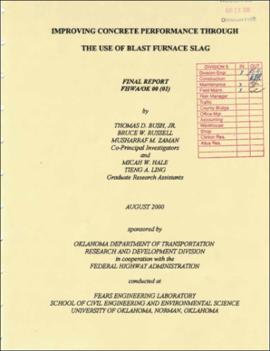| dc.description.abstract | A laboratory testing program was undertaken to evaluate the performance of ODOT Class AA and Class A concretes, specifically containing Oklahoma cements and aggregates, and utilizing partial replacement of portland cement (PC) with Grade 12 0 ground granulated blast furnace slag (BFS) and/or Class C fly ash (FA). Studies were conducted to examine performance aspects related to constituent materials (types and amounts used) as well as to construction/field issues. Blast furnace slag was used to replace portland cement on a 1: 1 basis by mass. Class C fly ash replaced portland cement at a 1.35:1 ratio, i.e., 1.35 lb. of fly ash replaced 1.0 lb. ofportland cement. Replacements rates examined were: none (control), 2 5 percent BFS, 15 percent FA, and the combination of2 5 percent BFS plus 15 percent FA. The primary variables examined were: 1) BFS and FA contents, 2 ) source of Type I cement, 3) mixing and curing temperature, and 4) concrete class (A and AA). Use of high range water reducers and treatment with silanes were also examined. As compared to control portland cement concrete, the use of Grade 12 0 BFS at the replacement rate tested had the following beneficial effects: 1) increased compressive, flexural, and tensile strengths (typically by 7 days for compressive strength), 2 ) substantially lower permeability (greatly reduced RCIP values and chloride ion absorption in the upper half inch depth), 3) reduced creep, and similar or slightly higher elastic modulus, and 4) consistent nature of performance. Blast furnace slag replacement (Grade 120) was also found to cause slight reductions in workability, and reduced effectiveness in entraining air when workability was decreased, or with low or elevated casting temperature. Setting times, freez.e thaw resistance, shrinkage, and chloride ion absorption when treated by silane, were found similar for concrete with blast furnace slag when compared to concrete made with ordinary portland cement. | |
